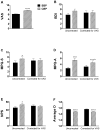Pain characteristic differences between subacute and chronic back pain
- PMID: 21497139
- PMCID: PMC3130842
- DOI: 10.1016/j.jpain.2011.01.008
Pain characteristic differences between subacute and chronic back pain
Abstract
Back pain is commonly classified based on duration. There is currently limited information regarding differences in the clinical features of back pain between these duration-based groupings. Here, we compared the pain characteristics of patients with subacute (SBP; pain 6-16 weeks, n = 40) and chronic back pain (CBP; pain ≥1 year, n = 37) recruited from the general population. CBP patients reported significantly higher pain intensity on the Visual Analogue Scale (VAS) compared to SBP patients. Based on this finding, we investigated group differences and their dependence on VAS for the Beck Depression Inventory (BDI), sensory and affective dimensions of the McGill Pain Questionnaire (MPQ-S and MPQ-A), Neuropathic Pain Scale (NPS), and the variability of spontaneous pain. Correction for VAS abolished significant group differences on the MPQ-S, MPQ-A and NPS. Only a significant difference in the variability of spontaneous pain was independent of VAS. Finally, whereas SBP patients displayed a higher incidence of unilateral pain radiating down the legs/buttocks, there was a shift towards more bilateral pain in CBP patients. In summary, SBP and CBP groups differ on 3 independent parameters: VAS ratings, pain location, and temporal dynamics of spontaneous pain.
Perspective: The present study reports differences in the characteristics of back pain between duration-based groupings in the general population. The main outcome of the study is the demonstration that a small number of descriptors are required to characterize the difference between SBP and CBP.
Copyright © 2011 American Pain Society. Published by Elsevier Inc. All rights reserved.
Figures



References
-
- Andersson GB, Svensson HO, Odén A. The intensity of work recovery in low back pain. Spine. 1983;8:880–884. - PubMed
-
- Apkarian AV, Krauss BR, Fredrickson BE, Szeverenyi NM. Imaging the pain of low back pain: Functional magnetic resonance imaging in combination with monitoring subjective pain perception allows the study of clinical pain states. Neurosci Lett. 2001;299:57–60. - PubMed
-
- Audette JF, Emenike E, Meleger AL. Neuropathic low back pain. Curr Pain Headache Rep. 2005;9:168–177. - PubMed
-
- Banks SM, Kerns RD. Explaining high rates of depression in chronic pain: A diathesis-stress framework. Psychol Bull. 1996;119:95–110.
-
- Beck AT, Rial WY, Rickels K. Psychological Reports. 1974. Short form of depression inventory: Cross-validation. - PubMed
Publication types
MeSH terms
Grants and funding
LinkOut - more resources
Full Text Sources
Medical

